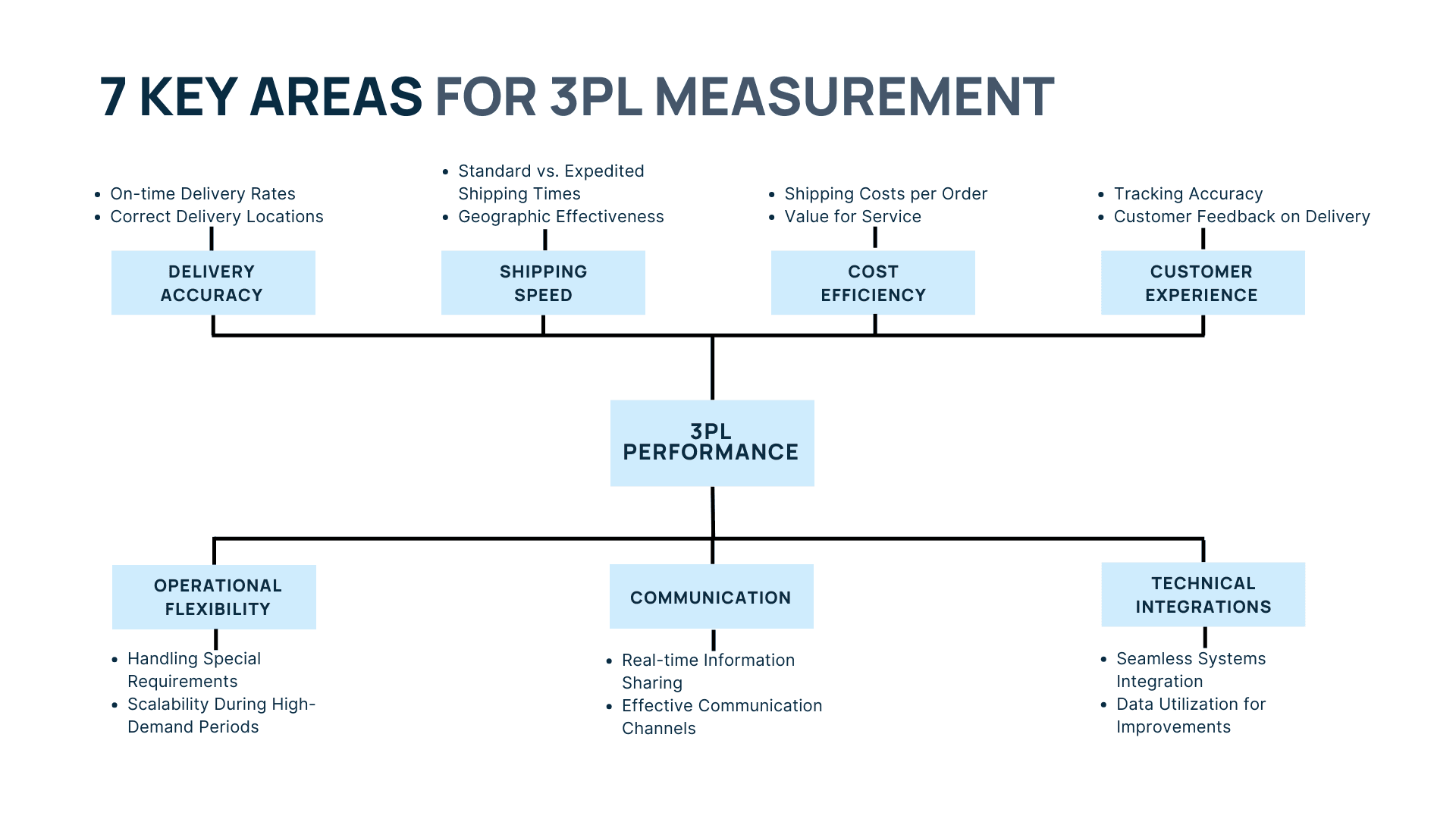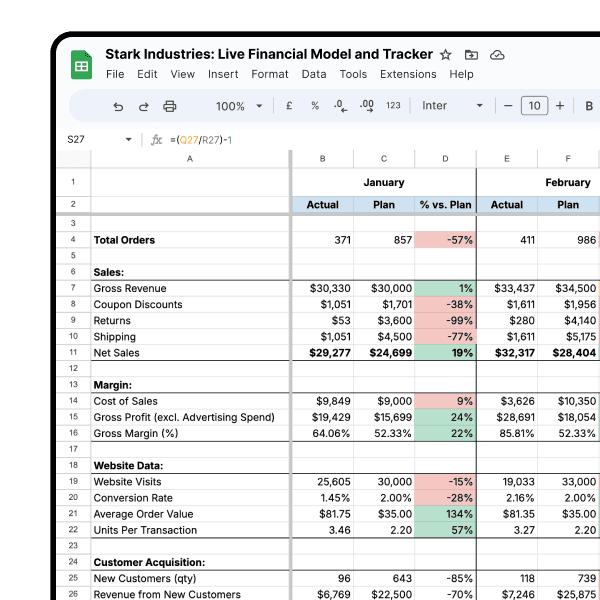Reporting & Analysis
26.10.2023
TLDR
Monitoring 3PLs is vital for customer satisfaction and brand reputation. Tailored KPIs can track on-time delivery, correct locations, shipping speed, efficiency, costs, tracking accuracy, customer feedback, special requests, scalability, transparency, communication, integration, and data utilization. Analyzing these metrics helps optimize operations, improve customer experiences, and ensure strategic 3PL partnerships that align with brand values and objectives.
Third-party logistics (3PL) partners are essential for managing and maintaining positive customer relationships. Even if you have created an exceptional brand, a poor experience provided by your 3PL can negatively impact customer loyalty. As a result, your cost of acquiring new customers may increase and your profitability may be compromised.
By reviewing your 3PL's shipping timeline performance and cost efficiency, your DTC brand can make data-driven decisions to either renegotiate contracts, set clear expectations, or seek alternative providers that offer better value for the cost incurred. An easy way to review your 3PL performance is to create a report showing all your key performance indicators (KPIs).
A Third-Party Logistics (3PL) partner is an external organization that handles logistics and supply chain management for a business. This includes transportation, warehousing, distribution, shipping, and customer service for product delivery. Partnering with a 3PL allows e-commerce brands to focus on core competencies like product development, marketing, and sales, while outsourcing logistics.
Before determining which metrics you should look at, it's important to note that different companies prioritize different KPIs. For instance, Amazon prioritizes the "Order to Ship Time" KPI, which measures the time it takes for an order to be shipped after it has been placed. This KPI enables Amazon to uphold its Prime shipping commitments. Another example is Zara, which utilizes the "Delivery In-Full, On-Time" (DIFOT) metric to assess the reliability of delivering orders to customers within the promised timeframe. Both of these KPIs provide valuable insights that drive operational improvements and influence contract negotiations with 3PLs.
How to Build a 3PL KPI report
So, how should you build your fulfilment KPIs report? Here's an overview of the key metrics.

Our 7 point framework for 3PL measurement
Shipping Accuracy
The first thing you should care about is the accuracy with which your 3PL partners deliver your goods to customers. Start with measuring these two critical metrics:
On-time Delivery Rates
This KPI gauges the timeliness of deliveries. A high on-time delivery rate ensures satisfaction and repeat business. Companies like FedEx constantly monitor this metric and claim an approximately 98% on-time delivery rate to maintain their industry-leading reputation.
Correct Delivery Locations
Ensuring that packages reach the correct addresses is a crucial part of the order fulfillment process. Incorrect deliveries tarnish brand image and incur additional costs. Walmart for instance, uses advanced geocoding algorithms to verify delivery addresses during the order process, significantly reducing incorrect deliveries.
Both metrics are critical for evaluating the reliability of your 3PL partner. Inaccuracies in either can lead to customer dissatisfaction and increased operational costs. Monitoring these metrics should be a regular activity for any e-commerce brand.
Shipping Speed
Your customers care about how fast their receive their packages—so shipping speed is a key measurement of 3PL performance. Here are some aspects to keep in mind as you look at shipping speed.
Standard vs. Expedited Shipping Times
Shipping speed is an essential metric to meet customer expectations. Companies offer multiple options, ranging from standard to expedited shipping, to meet different customer needs. Amazon's Prime service, for example, has set a benchmark with its 2-day shipping offering, pushing other retailers to speed up their delivery times. On the other hand, eBay offers a range of options, including economy shipping, that aligns with different customer priorities and budget constraints.
You should measure your 3PL’s shipping speed performance on a monthly or quarterly basis. Here are some metrics that you should track:
Average Shipping Time: Measures the average time taken from when an order is shipped to when it is delivered.
Use Airboxr to measure the performance of your shipping partners
Expedited Shipping Time: Measures how often expedited packages are delivered within the promised timeframe.
Late Shipments Percentage: Calculates the percentage of shipments that missed the estimated delivery window.
Order-to-Delivery Time: Measures the full cycle from order placement to the item reaching the customer.
Geographic Effectiveness
This refers to how efficiently a fulfillment partner can deliver to various geographical areas, both domestic and international. DHL, for instance, specializes in international shipping and markets itself on quick and reliable global delivery services. It segments its shipping speed by zones, providing transparent timeframes to customers based on their locations.
Not all 3PLs performance the same way in different locations. Some might be great in certain ZIP codes while struggling in others. Measure these metrics to determine if you need to switch providers:
Regional On-Time Delivery Rates: Measures on-time delivery percentages segmented by geographical areas.
Zone-Based Performance: Evaluates 3PL performance in specific shipping zones.
Delivery Density: Monitors the number of successful deliveries per area, which can help identify regions where the fulfillment partner excels or needs improvement.
International Shipping Time: Specifically evaluates the 3PL's effectiveness in delivering orders internationally within the committed time frame.
Localized Customer Feedback: Collect and analyze customer reviews and ratings based on different geographic locations to gain insights into regional performance.
Cost Efficiency
Different brands have different cost sensitivity when appointing a 3PL provider. Higher margins allow for faster and expensive shipping options, whereas lower margins might limit your ability to provide faster shipouts. With that in mind, look at these parameters to ensure you’re delivering on your brand promise.
Shipping Costs per Order
This metric evaluates the average shipping cost incurred for each order. Brands like Amazon have invested heavily in optimizing this metric, enabling them to offer free shipping options for many products as a part of their Prime subscription service.
Value for Service
This examines whether the cost paid to the 3PL is commensurate with the quality of service provided. For example, luxury brand Tiffany & Co. might employ a premium 3PL service to provide white-glove delivery, focusing on high-quality service over low cost.
Customer Experience
Tracking Accuracy
Accurate and real-time tracking throughout the order fulfillment process is critical for enhancing customer satisfaction. Companies like UPS employ sophisticated tracking systems that offer customers detailed, real-time updates at every stage of delivery.
You can measure this using the following metrics:
Tracking Error Rate: Measures the accuracy of tracking information.
Customer Queries about Tracking: A high number of queries may indicate tracking inaccuracy.
Customer Feedback on Delivery
Companies like Nordstrom encourage post-purchase reviews that specifically address the delivery experience. These reviews serve as firsthand data on delivery performance.
You can measure this using the following metrics:
Customer Satisfaction Score (CSAT): Measures customer satisfaction on a scale, often from 1 to 5, specifically focusing on the shipping and delivery aspect.
Net Promoter Score (NPS): Gauges customer loyalty by asking how likely they are to recommend the shipping and delivery service.
By carefully monitoring these metrics, brands can gain actionable insights into their 3PL partners' impact on the overall customer experience. For instance, a low CSAT score in delivery may indicate systemic issues that need to be addressed immediately. Likewise, tracking error rates can help identify problems in the tracking system that need rectification. The objective is to ensure the 3PL's performance aligns with the brand's commitment to customer service excellence.
Improve your DTC game. Sign up for weekly tips.
Operational Flexibility
Handling Special Requirements
Brands like Chewy offer personalized gifts and notes for pet owners. The ability of a 3PL to handle such special requests reflects its operational flexibility.
Measure the Special Request Success Rate for your 3PL—the percentage of special requests successfully fulfilled.
Scalability During High-Demand Periods
Companies like Target need 3PLs that can seamlessly scale during events like Black Friday. A 3PL's effectiveness here impacts both customer satisfaction and profitability.
Use these metrics to measure their performance on scalability:
Volume-to-Fulfillment Ratio: Assesses the 3PL's ability to manage increased order volumes.
Peak Season Performance: Measures key indicators like on-time delivery and accuracy during high-demand periods.
Transparency and Communication
Real-time Information Sharing
Transparency in shipping and delivery operations is crucial for effective decision-making. Companies like FedEx offer detailed tracking dashboards that not only benefit customers but also provide valuable insights to the business itself.
Start with these metrics:
Information Lag Time: Measures the delay in updating real-time shipping information.
Data Completeness: Evaluates the comprehensiveness of the tracking information provided.
Effective Communication Channels
Open and effective communication is key in handling unexpected issues. Retail giants like Walmart maintain dedicated liaisons with their 3PLs to manage real-time logistics challenges.
Start with measuring these metrics:
Response Time: Assesses how quickly the 3PL provider responds to queries or issues.
Resolution Rate: Measures the effectiveness of the 3PL in resolving issues that arise.
Transparency and communication are foundational for a successful partnership with a 3PL. These aspects not only help in proactive problem-solving but also contribute to smoother operations.
Technical Integrations
Seamless Systems Integration
For efficient operations, a 3PL's technology should easily integrate with a brand's existing systems. Companies like Shopify offer 3PLs that offer plug-and-play integrations for inventory and order management. You can also use a third-party app on Shopify, such as EasyShip, ShipStation, AfterShip, or Shippo to connect to your 3PL.
Data Utilization for Improvements
Brands like Nike leverage data analytics provided by their 3PLs to optimize supply chain efficiencies. This requires strong technological capabilities from the 3PL. Work with your 3PL to understand the actionable insights they can bring to the table using their data.
—
Selecting and collaborating with a third-party logistics provider (3PL) is an important decision that involves more than just looking at costs. By using the appropriate metrics, you can get a complete understanding of a 3PL's performance and use data to make informed choices that improve operational efficiency and customer satisfaction.
For e-commerce brands, it's crucial to set performance benchmarks for 3PL partners. Demand transparency, technology expertise, and commitment to improvement. Measure key performance indicators to hold 3PL accountable and align with your brand's values and objectives.
Your 3PL is not just a vendor but a strategic partner. Make them accountable, set clear performance standards, and ensure that they are met. Your customers—and your bottom line—will thank you.


